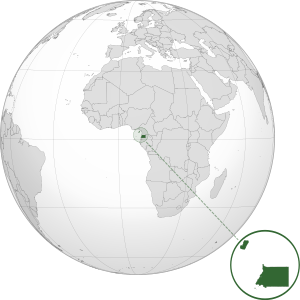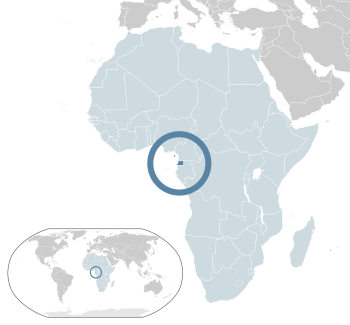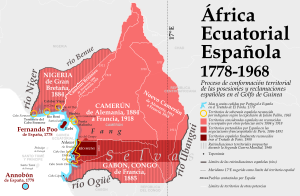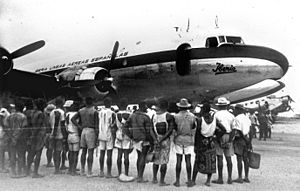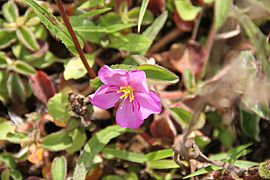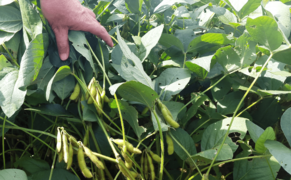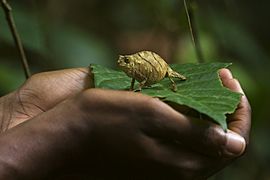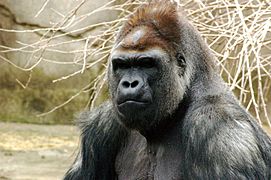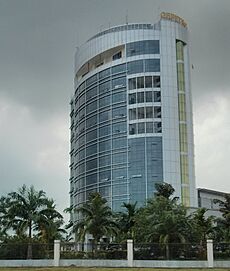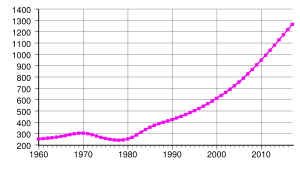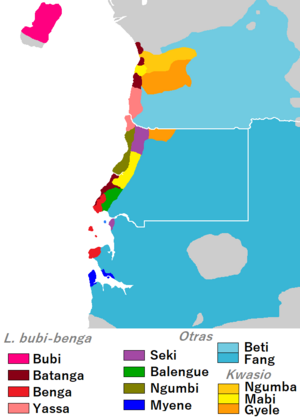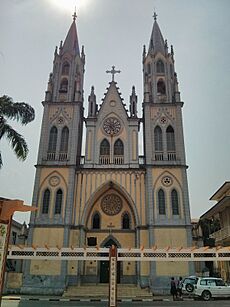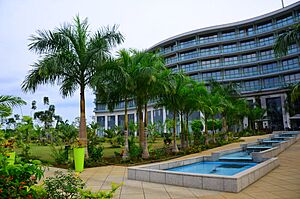Equatorial Guinea facts for kids
Quick facts for kids
Republic of Equatorial Guinea
|
|
|---|---|
|
|
|
|
Anthem: Caminemos pisando las sendas de nuestra inmensa felicidad (Spanish)
Let Us Walk Treading the Paths of Our Immense Happiness |
|
| Capital | Malabo (current) Ciudad de la Paz (under construction) 3°45′N 8°47′E / 3.750°N 8.783°E |
| Largest city | Malabo, Bata |
| Official languages |
|
| Recognised regional languages |
List
|
| Ethnic groups
(2020)
|
|
| Religion
(2020)
|
|
| Demonym(s) |
|
| Government | Unitary dominant-party presidential republic under a totalitarian dictatorship |
| Teodoro Obiang Nguema Mbasogo | |
| Teodoro Nguema Obiang Mangue | |
| Manuel Osa Nsue Nsua | |
| Legislature | Parliament |
| Senate | |
| Chamber of Deputies | |
| Independence
from Spain
|
|
|
• Declared
|
12 October 1968 |
| Area | |
|
• Total
|
28,050 km2 (10,830 sq mi) (141st) |
|
• Water (%)
|
negligible |
| Population | |
|
• 2024 estimate
|
1,795,834 (154th) |
| GDP (PPP) | 2023 estimate |
|
• Total
|
|
|
• Per capita
|
|
| GDP (nominal) | 2023 estimate |
|
• Total
|
|
|
• Per capita
|
|
| HDI (2022) | medium · 133rd |
| Currency | Central African CFA franc (XAF) |
| Time zone | UTC+1 (WAT) |
| Date format | dd/mm/yyyy |
| Driving side | right |
| Calling code | +240 |
| ISO 3166 code | GQ |
| Internet TLD | .gq |
|
|
Equatorial Guinea, officially the Republic of Equatorial Guinea, is a country on the west coast of Central Africa, with an area of 28,000 square kilometres (11,000 sq mi). Formerly the colony of Spanish Guinea, its post-independence name refers to its location near both the Equator and in the African region of Guinea. As of 2024[update], the country had a population of 1,795,834, over 85% of whom are members of the Fang people, the country's dominant ethnic group. The Bubi people, indigenous to Bioko, are the second largest group at approximately 6.5% of the population.
Equatorial Guinea consists of two parts, an insular and a mainland region. The insular region consists of the islands of Bioko (formerly Fernando Pó) in the Gulf of Guinea and Annobón, a small volcanic island which is the only part of the country south of the equator. Bioko Island is the northernmost part of Equatorial Guinea and is the site of the country's capital, Malabo. The Portuguese-speaking island nation of São Tomé and Príncipe is located between Bioko and Annobón.
The mainland region, Río Muni, is bordered by Cameroon to the north and Gabon to the south and east. It is the location of Bata, Equatorial Guinea's second largest city, and Ciudad de la Paz, the country's planned future capital. Río Muni also includes several small offshore islands, such as Corisco, Elobey Grande, and Elobey Chico. The country is a member of the African Union, Francophonie, OPEC, and the CPLP.
After becoming independent from Spain in 1968, Equatorial Guinea was ruled by Francisco Macías Nguema. He declared himself president for life in 1972, but was overthrown in a coup in 1979 by his nephew, Teodoro Obiang Nguema Mbasogo, who has served as the country's president since. Both presidents have been widely characterized as dictators by foreign observers. Since the mid-1990s, Equatorial Guinea has become one of sub-Saharan Africa's largest oil producers. It has subsequently become the richest country per capita in Africa, and its gross domestic product (GDP) adjusted for purchasing power parity (PPP) per capita ranks 43rd in the world; however, the wealth is distributed extremely unevenly, with few people benefiting from the oil riches. The country ranks 144th on the 2019 Human Development Index, with less than half the population having access to clean drinking water and 7.9% of children dying before the age of five. Equatorial Guinea's nominal GDP per capita is $10,982 in 2021 according to OPEC.
Since Equatorial Guinea is a former Spanish colony, Spanish is the main official language. French and (as of 2010[update]) Portuguese have also been made official, but they are not as widely used. Aside from the partially recognized Sahrawi Arab Democratic Republic, it is the only country situated in Mainland Africa in where Spanish is an official language (Spanish is also spoken in the African parts of Spain: the Canary Islands, Ceuta and Melilla). It is also the most widely spoken language (considerably more than the other two official languages); according to the Instituto Cervantes, 87.7% of the population has a good command of Spanish.
History
Pygmies probably once lived in the continental region that is now Equatorial Guinea, but are today found only in isolated pockets in southern Río Muni. Bantu migrations likely started around 2,000 BC from between south-east Nigeria and north-west Cameroon (the Grassfields). They must have settled continental Equatorial Guinea around 500 BC at the latest. The earliest settlements on Bioko Island are dated to AD 530. The Annobón population, originally native to Angola, was introduced by the Portuguese via São Tomé island.
First European contact and Portuguese rule (1472–1778)

The Portuguese explorer Fernando Pó, seeking a path to India, is credited as being the first European to see the island of Bioko, in 1472. He called it Formosa ("Beautiful"), but it quickly took on the name of its European discoverer. Fernando Pó and Annobón were colonized by Portugal in 1474. The first factories were established on the islands around 1500 as the Portuguese quickly recognized the positives of the islands including volcanic soil and disease-resistant highlands. Despite natural advantages, initial Portuguese efforts in 1507 to establish a sugarcane plantation and town near what is now Concepción on Fernando Pó failed due to Bubi hostility and fever. The main island's rainy climate, extreme humidity and temperature swings took a major toll on European settlers from the beginning, and it would be centuries before attempts restarted.
Early Spanish rule and lease to Britain (1778–1844)
In 1778, Queen Maria I of Portugal and King Charles III of Spain signed the Treaty of El Pardo which ceded Bioko, adjacent islets, and commercial rights to the Bight of Biafra between the Niger and Ogoue rivers to Spain in exchange for large areas in South America that are now Western Brazil. Brigadier Felipe José, Count of Arjelejos formally took possession of Bioko from Portugal on 21 October 1778. After sailing for Annobón to take possession, the Count died of disease caught on Bioko and the fever-ridden crew mutinied. The crew landed on São Tomé instead where they were imprisoned by the Portuguese authorities after having lost over 80% of their men to sickness. As a result of this disaster, Spain was thereafter hesitant to invest heavily in its new possession. However, despite the setback Spaniards began to use the island as a base for slave trading on the nearby mainland. Between 1778 and 1810, the territory of what became Equatorial Guinea was administered by the Viceroyalty of the Río de la Plata, based in Buenos Aires.
Unwilling to invest heavily in the development of Fernando Pó, from 1827 to 1843, the Spanish leased a base at Malabo on Bioko to the United Kingdom which it had sought as part of its efforts to suppress the transatlantic slave trade. Without Spanish permission, the British moved the headquarters of the Mixed Commission for the Suppression of Slave Traffic to Fernando Pó in 1827, before moving it back to Sierra Leone under an agreement with Spain in 1843. Spain's decision to abolish slavery in 1817 at British insistence damaged the colony's perceived value to the authorities and so leasing naval bases was an effective revenue earner from an otherwise unprofitable possession. An agreement by Spain to sell its African colony to the British was cancelled in 1841 due to metropolitan public opinion and opposition by Spanish Congress.
Late 19th century (1844–1900)
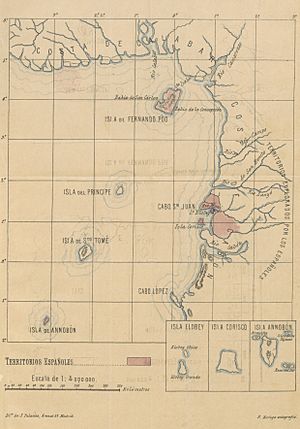
In 1844, the British returned the island to Spanish control and the area became known as the "Territorios Españoles del Golfo de Guinea". Due to epidemics, Spain did not invest much in the colony, and in 1862, an outbreak of yellow fever killed many of the whites that had settled on the island. Despite this, plantations continued to be established by private citizens through the second half of the 19th century.
The plantations of Fernando Pó were mostly run by a black Creole elite, later known as Fernandinos. The British settled some 2,000 Sierra Leoneans and freed slaves there during their rule, and a trickle of immigration from West Africa and the West Indies continued after the British left. A number of freed Angolan slaves, Portuguese-African creoles and immigrants from Nigeria, and Liberia also began to be settled in the colony, where they quickly began to join the new group. To the local mix were added Cubans, Filipinos, Jews and Spaniards of various colours, many of whom had been deported to Africa for political or other crimes, as well as some settlers backed by the government.
By 1870, the prognosis of whites that lived on the island was much improved after recommendations that they live in the highlands, and by 1884 much of the minimal administrative machinery and key plantations had moved to Basile hundreds of meters above sea level. Henry Morton Stanley had labeled Fernando Pó "a jewel which Spain did not polish" for refusing to enact such a policy. Despite the improved survival chances of Europeans living on the island, Mary Kingsley, who was staying on the island, still described Fernando Pó as "a more uncomfortable form of execution" for Spaniards appointed there.
There was also a trickle of immigration from the neighboring Portuguese islands, escaped slaves, and prospective planters. Although a few of the Fernandinos were Catholic and Spanish-speaking, about nine-tenths of them were Protestant and English-speaking on the eve of the First World War, and pidgin English was the lingua franca of the island. The Sierra Leoneans were particularly well placed as planters while labor recruitment on the Windward coast continued. The Fernandinos became traders and middlemen between the natives and Europeans. A freed slave from the West Indies by way of Sierra Leone named William Pratt established the cocoa crop on Fernando Pó.
Early 20th century (1900–1945)

Spain had not occupied the large area in the Bight of Biafra to which it had right by treaty, and the French had expanded their occupation at the expense of the territory claimed by Spain. Madrid only partly backed the explorations of men like Manuel Iradier who had signed treaties in the interior as far as Gabon and Cameroon, leaving much of the land out of "effective occupation" as demanded by the terms of the 1885 Berlin Conference. Minimal government backing for mainland annexation came as a result of public opinion and a need for labour on Fernando Pó.
The eventual treaty of Paris in 1900 left Spain with the continental enclave of Río Muni, only 26,000 km2 out of the 300,000 stretching east to the Ubangi river which the Spaniards had initially claimed.
Land regulations issued in 1904–1905 favoured Spaniards, and most of the later big planters arrived from Spain after that. An agreement was made with Liberia in 1914 to import cheap labor. Due to malpractice however, the Liberian government eventually ended the treaty after revelations about the state of Liberian workers on Fernando Pó in the Christy Report which brought down the country's president Charles D. B. King in 1930.

By the late nineteenth century, the Bubi were protected from the demands of the planters by Spanish Claretian missionaries, who were very influential in the colony and eventually organised the Bubi into little mission theocracies reminiscent of the famous Jesuit reductions in Paraguay. Catholic penetration was furthered by two small insurrections in 1898 and 1910 protesting conscription of forced labour for the plantations. The Bubi were disarmed in 1917, and left dependent on the missionaries. Serious labour shortages were temporarily solved by a massive influx of refugees from German Kamerun, along with thousands of white German soldiers who stayed on the island for several years.
Between 1926 and 1959, Bioko and Río Muni were united as the colony of Spanish Guinea. The economy was based on large cacao and coffee plantations and logging concessions and the workforce was mostly immigrant contract labour from Liberia, Nigeria, and Cameroun. Between 1914 and 1930, an estimated 10,000 Liberians went to Fernando Po under a labour treaty that was stopped altogether in 1930. With Liberian workers no longer available, planters of Fernando Po turned to Río Muni. Campaigns were mounted to subdue the Fang people in the 1920s, at the time that Liberia was beginning to cut back on recruitment. There were garrisons of the colonial guard throughout the enclave by 1926, and the whole colony was considered 'pacified' by 1929.
The Spanish Civil War had a major impact on the colony. A group of 150 Spanish whites, including the Governor-General and Vice-Governor-General of Río Muni, created a socialist party called the Popular Front in the enclave which served to oppose the interests of the Fernando Pó plantation owners. When the War broke out Francisco Franco ordered Nationalist forces based in the Canaries to ensure control over Equatorial Guinea. In September 1936, Nationalist forces backed by Falangists from Fernando Pó, similarly to what happened in Spain proper, took control of Río Muni, which under Governor-General Luiz Sanchez Guerra Saez and his deputy Porcel had backed the Republican government. By November, the Popular Front and its supporters had been defeated and Equatorial Guinea secured for Franco. The commander in charge of the occupation, Juan Fontán Lobé, was appointed Governor-General by Franco and began to exert more Spanish control over the enclave interior.
Río Muni officially had a little over 100,000 people in the 1930s; escape into Cameroun or Gabon was easy. Fernando Pó thus continued to suffer from labour shortages. The French only briefly permitted recruitment in Cameroun, and the main source of labour came to be Igbo smuggled in canoes from Calabar in Nigeria. This resolution led to Fernando Pó becoming one of Africa's most productive agricultural areas after the Second World War.
Final years of Spanish rule (1945–1968)

Politically, post-war colonial history has three fairly distinct phases: up to 1959, when its status was raised from "colonial" to "provincial", following the approach of the Portuguese Empire; between 1960 and 1968, when Madrid attempted a partial decolonisation aimed at keeping the territory as part of the Spanish system; and from 1968 on, after the territory became an independent republic. The first phase consisted of little more than a continuation of previous policies; these closely resembled the policies of Portugal and France, notably in dividing the population into a vast majority governed as 'natives' or non-citizens, and a very small minority (together with whites) admitted to civic status as emancipados, assimilation to the metropolitan culture being the only permissible means of advancement.
This "provincial" phase saw the beginnings of nationalism, but chiefly among small groups who had taken refuge from the Caudillo's paternal hand in Cameroun and Gabon. They formed two bodies: the Movimiento Nacional de Liberación de la Guinea (MONALIGE), and the Idea Popular de Guinea Ecuatorial (IPGE). By the late 1960s, much of the African continent had been granted independence. Aware of this trend, the Spanish began to increase efforts to prepare the country for independence. The gross national product per capita in 1965 was $466, which was the highest in black Africa; the Spanish constructed an international airport at Santa Isabel, a television station and increased the literacy rate to 89%. In 1967, the number of hospital beds per capita in Equatorial Guinea was higher than Spain itself, with 1637 beds in 16 hospitals. By the end of colonial rule, the number of Africans in higher education was in only the double digits.
A decision of 9 August 1963, approved by a referendum of 15 December 1963, gave the territory a measure of autonomy and the administrative promotion of a 'moderate' group, the Movimiento de Unión Nacional de Guinea Ecuatorial (MUNGE). This was unsuccessful, and, with growing pressure for change from the UN, Madrid was gradually forced to give way to the currents of nationalism. Two General Assembly resolutions were passed in 1965 ordering Spain to grant independence to the colony, and in 1966, a UN Commission toured the country before recommending the same thing. In response, the Spanish declared that they would hold a constitutional convention on 27 October 1967 to negotiate a new constitution for an independent Equatorial Guinea. The conference was attended by 41 local delegates and 25 Spaniards. The Africans were principally divided between Fernandinos and Bubi on one side, who feared a loss of privileges and 'swamping' by the Fang majority, and the Río Muni Fang nationalists on the other. At the conference, the leading Fang figure, the later first president Francisco Macías Nguema, gave a controversial speech in which he claimed that Adolf Hitler had "saved Africa". After nine sessions, the conference was suspended due to deadlock between the "unionists" and "separatists" who wanted a separate Fernando Pó. Macías resolved to travel to the UN to bolster international awareness of the issue, and his firebrand speeches in New York contributed to Spain naming a date for both independence and general elections. In July 1968 virtually all Bubi leaders went to the UN in New York to try and raise awareness for their cause, but the world community was uninterested in quibbling over the specifics of colonial independence. The 1960s were a time of great optimism over the future of the former African colonies, and groups that had been close to European rulers, like the Bubi, were not viewed positively.
Independence under Macías (1968–1979)

Independence from Spain was gained on 12 October 1968, at noon in the capital, Malabo. The new country became the Republic of Equatorial Guinea (the date is celebrated as the country's Independence Day). Macías became president in the country's only free and fair election to date. The Spanish (ruled by Franco) had backed Macías in the election; much of his campaigning involved visiting rural areas of Río Muni and promising that they would have the houses and wives of the Spanish if they voted for him. He had won in the second round of voting.
During the Nigerian Civil War, Fernando Pó was inhabited by many Biafra-supporting Ibo migrant workers and many refugees from the breakaway state fled to the island. The International Committee of the Red Cross began running relief flights out of Equatorial Guinea, but Macías quickly shut the flights down, refusing to allow them to fly diesel fuel for their trucks nor oxygen tanks for medical operations. The Biafran separatists were starved into submission without international backing.
After the Public Prosecutor complained about "excesses and maltreatment" by government officials, Macías had 150 alleged coup-plotters executed in a purge on Christmas Eve 1969, all of whom were political opponents. Macias Nguema further consolidated his totalitarian powers by outlawing opposition political parties in July 1970 and making himself president for life in 1972. He broke off ties with Spain and the West. In spite of his condemnation of Marxism, which he deemed "neo-colonialist", Equatorial Guinea maintained special relations with communist states, notably China, Cuba, East Germany and the USSR. Macias Nguema signed a preferential trade agreement and a shipping treaty with the Soviet Union. The Soviets also made loans to Equatorial Guinea. The shipping agreement gave the Soviets permission for a pilot fishery development project and also a naval base at Luba. In return, the USSR was to supply fish to Equatorial Guinea. China and Cuba also gave different forms of financial, military, and technical assistance to Equatorial Guinea, which got them a measure of influence there. For the USSR, there was an advantage to be gained in the war in Angola from access to Luba base and later on to Malabo International Airport.
In 1974, the World Council of Churches affirmed that large numbers of people had been murdered since 1968 in an ongoing reign of terror. A quarter of the entire population had fled abroad, they said, while 'the prisons are overflowing and to all intents and purposes form one vast concentration camp'. Out of a population of 300,000, an estimated 80,000 were killed. Apart from allegedly committing genocide against the ethnic minority Bubi people, Macias Nguema ordered the deaths of thousands of suspected opponents, closed down churches and presided over the economy's collapse as skilled citizens and foreigners fled the country.
Obiang (1979–present)

The nephew of Macías Nguema, Teodoro Obiang deposed his uncle on 3 August 1979, in a bloody coup d'état; over two weeks of civil war ensued until Macías Nguema was captured. He was tried and executed soon afterward, with Obiang succeeding him as a less bloody, but still authoritarian president.
In 1995, Mobil, an American oil company, discovered oil in Equatorial Guinea. The country subsequently experienced rapid economic development, but earnings from the country's oil wealth have not reached the population and the country ranks low on the UN human development index. 7.9% of children die before the age of 5, and more than 50% of the population lacks access to clean drinking water. President Teodoro Obiang is widely suspected of using the country's oil wealth to enrich himself and his associates. In 2006, Forbes estimated his personal wealth at $600 million.
In 2011, the government announced it was planning a new capital for the country, named Oyala. The city was renamed Ciudad de la Paz ("City of Peace") in 2017.
As of February 2016[update], Obiang is Africa's second-longest serving dictator after Cameroon's Paul Biya. Equatorial Guinea was elected as a non-permanent member of the United Nations Security Council 2018–2019. On 7 March 2021, there were munition explosions at a military base near the city of Bata, causing 98 deaths and 600 people being injured and treated at the hospital. In November 2022, Obiang was re-elected in the 2022 Equatorial Guinean general election with 99.7% of the vote amid accusations of fraud by the opposition.
Geography
Equatorial Guinea is on the west coast of Central Africa. The country consists of a mainland territory, Río Muni, which is bordered by Cameroon to the north and Gabon to the east and south, and five small islands, Bioko, Corisco, Annobón, Elobey Chico (Small Elobey), and Elobey Grande (Great Elobey). Bioko, the site of the capital, Malabo, lies about 40 kilometers (25 mi) off the coast of Cameroon. Annobón Island is about 350 kilometers (220 mi) west-south-west of Cape Lopez in Gabon. Corisco and the two Elobey islands are in Corisco Bay, on the border of Río Muni and Gabon.
Equatorial Guinea lies between latitudes 4°N and 2°S, and longitudes 5° and 12°E. Despite its name, no part of the country's territory lies on the equator—it is in the northern hemisphere, except for the insular Annobón Province, which is about 155 km (96 mi) south of the equator.
Climate
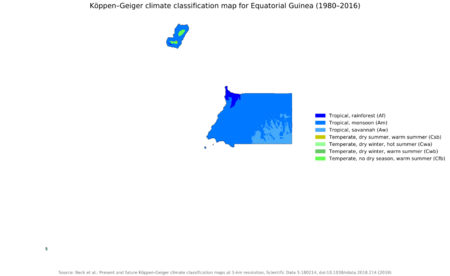
Equatorial Guinea has a tropical climate with distinct wet and dry seasons. From June to August, Río Muni is dry and Bioko wet; from December to February, the reverse occurs. In between it, there is a gradual transition. Rain or mist occurs daily on Annobón, where a cloudless day has never been registered. The temperature at Malabo, Bioko, ranges from 16 °C (61 °F) to 33 °C (91 °F), though on the southern Moka Plateau, normal high temperatures are only 21 °C (70 °F). In Río Muni, the average temperature is about 27 °C (81 °F). Annual rainfall varies from 1,930 mm (76 in) at Malabo to 10,920 mm (430 in) at Ureka, Bioko, but Río Muni is somewhat drier.
Ecology
Equatorial Guinea spans several ecoregions. Río Muni region lies within the Atlantic Equatorial coastal forests ecoregion except for patches of Central African mangroves on the coast, especially in the Muni River estuary. The Cross-Sanaga-Bioko coastal forests ecoregion covers most of Bioko and the adjacent portions of Cameroon and Nigeria on the African mainland, and the Mount Cameroon and Bioko montane forests ecoregion covers the highlands of Bioko and nearby Mount Cameroon. The São Tomé, Príncipe, and Annobón moist lowland forests ecoregion covers all of Annobón, as well as São Tomé and Príncipe.
The country had a 2018 Forest Landscape Integrity Index mean score of 7.99/10, ranking it 30th globally out of 172 countries.
- Ecology of Equatorial Guinea
-
Near Ciudad de la Paz
-
The Great Bioko mountain.jpg
Wildlife
Equatorial Guinea is home to gorillas, chimpanzees, various monkeys, leopards, buffalo, antelope, elephants, hippopotamuses, crocodiles, and various snakes, including pythons.
- Wildlife of Equatorial Guinea
Administrative divisions
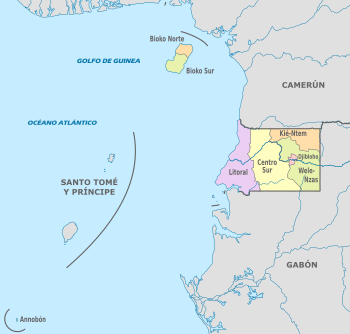
Equatorial Guinea is divided into eight provinces. The newest province is Djibloho, created in 2017 with its headquarters at Ciudad de la Paz, the country's future capital. The eight provinces are as follows (numbers correspond to those on the map; provincial capitals appear in parentheses):
- Annobón (San Antonio de Palé)
- Bioko Norte (Malabo)
- Bioko Sur (Luba)
- Centro Sur (Evinayong)
- Djibloho (Ciudad de la Paz)
- Kié-Ntem (Ebebiyín)
- Litoral (Bata)
- Wele-Nzas (Mongomo)
The provinces are further divided into 19 districts and 37 municipalities.
Economy
Before the nation's independence from Spain, Equatorial Guinea exported cocoa, coffee and timber, mostly to its colonial ruler, Spain, but also to Germany and the UK. On 1 January 1985, the country became the first non-Francophone African member of the franc zone, adopting the CFA franc as its currency. The national currency, the ekwele, had previously been linked to the Spanish peseta.
The discovery of large oil reserves in 1996 and its subsequent exploitation contributed to a dramatic increase in government revenue. As of 2004[update], Equatorial Guinea is the third-largest oil producer in Sub-Saharan Africa. Its oil production has risen to 360,000 barrels per day (57,000 m3/d), up from 220,000 only two years earlier. Oil companies operating in Equatorial Guinea include ExxonMobil, Marathon Oil, Kosmos Energy and Chevron.
In July 2004, the United States Senate published an investigation into Riggs Bank, a Washington-based bank into which most of Equatorial Guinea's oil revenues were paid until recently, and which also banked for Chile's Augusto Pinochet. The Senate report showed at least $35 million siphoned off by Obiang, his family and regime senior officials. The president has denied any wrongdoing. Riggs Bank in February 2005 paid $9 million in restitution for Pinochet's banking, no restitution was made with regard to Equatorial Guinea.
Forestry, farming, and fishing are also major components of the country's gross domestic product (GDP). Subsistence farming predominates. Agriculture is the country's main source of employment, providing income for 57% of rural households and employment for 52% of the workforce. From 2000 to 2010, Equatorial Guinea had the highest average annual increase in GDP, 17%.
Equatorial Guinea is a member of the Organization for the Harmonization of Business Law in Africa (OHADA). Equatorial Guinea is also a member of the Central African Monetary and Economic Union (CEMAC), a subregion that comprises more than 50 million people. Equatorial Guinea tried to be validated as an Extractive Industries Transparency Initiative (EITI)-compliant country. The country obtained candidate status on 22 February 2008; when Equatorial Guinea applied to extend the deadline for completing EITI's validation, the EITI Board did not agree to the extension.
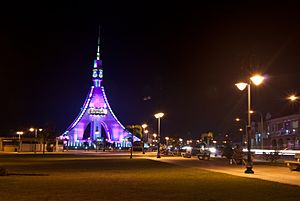
According to the World Bank, Equatorial Guinea has the highest gross national income (GNI) per capita of any African country, 83 times larger than the GNI per capita of Burundi, the poorest country. However, Equatorial Guinea has extreme poverty brought about by wealth inequality. According to the 2016 United Nations Human Development Report, Equatorial Guinea had a GDP per capita of $21,517, one of the highest levels of wealth in Africa. However, it is one of the most unequal countries in the world according to the Gini index, with 70 per cent of the population living on one dollar a day. The country ranks 145th out of 189 on the United Nations Human Development Index in 2019.
Hydrocarbons account for 97% of the state's exports, and it is a member of the African Petroleum Producers Organization. In 2020, it faces its eighth year of recession, due in part to endemic corruption. The economy of Equatorial Guinea was expected to grow about 2.6% in 2021, a projection that was based on the successful completion of a large gas project and the recovery of the world economy by the second half of the year. But the country is expected to return to recession in 2022, with a real GDP decline of about 4.4%. In 2022, the country's Gini coefficient was 58.8.
Transportation


Due to the large oil industry in the country, internationally recognized carriers flew to Malabo International Airport, which, in May 2014, had several direct connections to Europe and West Africa. There are three airports in Equatorial Guinea—Malabo International Airport, Bata Airport and the Annobón Airport on the island of Annobón. Malabo International Airport is the only international airport.
Every airline registered in Equatorial Guinea appears on the list of air carriers prohibited in the European Union (EU), which means that they are banned from operating services of any kind within the EU. However, freight carriers provide service from European cities to the capital.
Demographics
| Year | Million |
|---|---|
| 1950 | 0.2 |
| 2000 | 0.6 |
| 2020 | 1.4 |
The majority of the people of Equatorial Guinea are of Bantu origin. The largest ethnic group, the Fang, is indigenous to the mainland, but substantial migration to Bioko Island since the 20th century means the Fang population exceeds that of the earlier Bubi inhabitants. The Fang constitute 80% of the population and comprise around 67 clans. Those in the northern part of Río Muni speak Fang-Ntumu, while those in the south speak Fang-Okah; the two dialects have differences but are mutually intelligible. Dialects of Fang are also spoken in parts of neighboring Cameroon (Bulu) and Gabon. These dialects, while still intelligible, are more distinct. The Bubi, who constitute 15% of the population, are indigenous to Bioko Island. The traditional demarcation line between Fang and 'Beach' (inland) ethnic groups was the village of Niefang (limit of the Fang), east of Bata.
Coastal ethnic groups, sometimes referred to as Ndowe or "Playeros" (Beach People in Spanish): Combes, Bujebas, Balengues, and Bengas on the mainland and small islands, and Fernandinos, a Krio community on Bioko Island together comprise 5% of the population. Europeans (largely of Spanish or Portuguese descent, some with partial African ancestry) also live in the country, but most ethnic Spaniards left after independence.
A growing number of foreigners from neighboring Cameroon, Nigeria, and Gabon have immigrated to the country. According to the Encyclopedia of the Stateless Nations (2002) 7% of Bioko islanders were Igbo, an ethnic group from southeastern Nigeria. Equatorial Guinea received Asians and native Africans from other countries as workers on cocoa and coffee plantations. Other black Africans came from Liberia, Angola, and Mozambique. Most of the Asian population is Chinese, with small numbers of Indians.
Languages
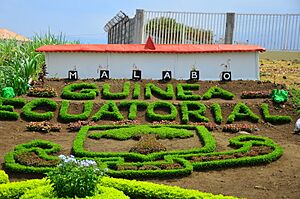
Since its independence in 1968, the main official language of Equatorial Guinea has been Spanish (the local variant is Equatoguinean Spanish), which acts as a lingua franca among its different ethnic groups. In 1970, during Macías' rule, Spanish was replaced by Fang, the language of its majority ethnic group, to which Macías belonged. That decision was reverted in 1979 after Macías' fall. Spanish remained as its lone official language until 1998, when French was added as its second one, as it had previously joined the Economic and Monetary Community of Central Africa (CEMAC), whose founding members are French-speaking nations, two of them (Cameroon and Gabon) surrounding its continental region. Portuguese was adopted as its third official language in 2010. Spanish has been an official language since 1844. It is still the language of education and administration. 67.6% of Equatorial Guineans can speak it, especially those living in the capital, Malabo. French was only made official in order to join the Francophonie, and it is not locally spoken, except in some border towns.
Aboriginal languages are recognised as integral parts of the "national culture" (Constitutional Law No. 1/1998, 21 January). Indigenous languages (some of them creoles) include Fang, Bube, Benga, Ndowe, Balengue, Bujeba, Bissio, Gumu, Igbo, Pichinglis, Fa d'Ambô and the nearly extinct Baseke. Most African ethnic groups speak Bantu languages.
Fa d'Ambô, a Portuguese creole, is in use in Annobón Province, in Malabo, and on Equatorial Guinea's mainland. Many residents of Bioko can also speak Spanish, particularly in the capital, and the local trade language, Pichinglis, an English-based creole. Spanish is not spoken much in Annobón. In government and education, Spanish is used. Noncreolized Portuguese is used as a liturgical language by local Catholics. The Annobonese ethnic community tried to gain membership in the Community of Portuguese Language Countries (CPLP). The government financed an Instituto Internacional da Língua Portuguesa (IILP) sociolinguistic study in Annobón. It documented strong links with the Portuguese creole populations in São Tomé and Príncipe, Cape Verde and Guinea-Bissau.
Due to historical and cultural ties, in 2010, the legislature amended Article 4 of the Constitution of Equatorial Guinea to establish Portuguese as an official language of the Republic. This was an effort by the government to improve its communications, trade, and bilateral relations with Portuguese-speaking countries. It also recognises long historical ties with Portugal and with Portuguese-speaking peoples of Brazil, São Tomé and Príncipe, and Cape Verde.
Some of the motivations for Equatorial Guinea's pursuit of membership in the Community of Portuguese Language Countries (CPLP) included access to several professional and academic exchange programmes and facilitated cross-border circulation of citizens. The adoption of Portuguese as an official language was the primary requirement to apply for CPLP acceptance. In addition, the country was told it must adopt political reforms allowing effective democracy and respect for human rights. The national parliament discussed this law in October 2011.
In February 2012, Equatorial Guinea's foreign minister signed an agreement with the IILP on the promotion of Portuguese in the country. In July 2012, the CPLP refused Equatorial Guinea full membership, primarily because of its continued serious violations of human rights. The government responded by legalising political parties, declaring a moratorium on the death penalty, and starting a dialog with all political factions. Additionally, the IILP secured land from the government for the construction of Portuguese language cultural centres in Bata and Malabo. At its tenth summit in Dili in July 2014, Equatorial Guinea was admitted as a CPLP member. Abolition of the death penalty and the promotion of Portuguese as an official language were preconditions of the approval.
Religion
| Religion in Equatorial Guinea | ||||
|---|---|---|---|---|
| Religion | per cent | |||
| Roman Catholic | 88% | |||
| Other (indigenous beliefs / Baháʼí) | 5% | |||
| Protestant | 5% | |||
| Muslim | 2% | |||
The principal religion in Equatorial Guinea is Christianity, the faith of 93% of the population. Roman Catholics make up the majority (88%), while a minority are Protestants (5%). Of the population, 2% follows Islam (mainly Sunni). The remaining 5% practise Animism, Baháʼí, and other beliefs, and traditional animist beliefs are often mixed with Catholicism.
Health
Equatorial Guinea's malaria programs in the early 21st century achieved success in reducing malaria infection and mortality. Their program consists of twice-yearly indoor residual spraying (IRS), the introduction of artemisinin combination treatment (ACTs), the use of intermittent preventive treatment in pregnant women (IPTp), and the introduction of long-lasting insecticide-treated mosquito nets (LLINs). Their efforts resulted in a reduction in all-cause under-five mortality from 152 to 55 deaths per 1,000 live births (down 64%), a drop that coincided with the launch of the program.
In June 2014, four cases of polio were reported, making it the country's first outbreak of that disease.
Education
Among sub-Saharan African countries, Equatorial Guinea has one of the highest literacy rates. According to the Central Intelligence Agency's World Factbook, as of 2015[update], 95.3% of the population age 15 and over were able to read and write in the country. Under Francisco Macias, few children received any type of education. Under President Obiang, the illiteracy rate dropped from 73% to 13%, and the number of primary school students rose from 65,000 in 1986 to more than 100,000 in 1994. Education is free and compulsory for children between the ages of 6 and 14.
The Equatorial Guinea government has partnered with Hess Corporation and The Academy for Educational Development (AED) to establish a $20 million education program for primary school teachers to teach modern child development techniques. There are now 51 model schools whose active pedagogy will be a national reform.
The country has one university, the Universidad Nacional de Guinea Ecuatorial (UNGE), with a campus in Malabo and a Faculty of Medicine located in Bata on the mainland. In 2009 the university produced the first 110 national doctors. The Bata Medical School is supported principally by the government of Cuba and staffed by Cuban medical educators and physicians.
Culture
In June 1984, the First Hispanic-African Cultural Congress was convened to explore the cultural identity of Equatorial Guinea.
Tourism
As of 2020[update], Equatorial Guinea has no UNESCO World Heritage Site or tentative sites for the World Heritage List. The country also has no documented heritage listed in the Memory of the World Programme of UNESCO nor any intangible cultural heritage listed in the UNESCO Intangible Cultural Heritage List.
Tourist attractions are the colonial quarter in Malabo, the southern part of the island Bioko where you can hike to the Iladyi cascades and to remote beaches to watch nesting turtles, Bata with its shoreline Paseo Maritimo and the tower of liberty, Mongomo with its basilica (the second largest Catholic church in Africa) and the new planned and built capital Ciudad de la Paz.
Media and communications
The principal means of communication within Equatorial Guinea are three state-operated FM radio stations: the BBC World Service, Radio France Internationale and Gabon-based Africa No 1 broadcast on FM in Malabo. There is also an independent radio option called Radio Macuto; it is a web-based radio and news source known for publishing news that call out Obiang's regime. There are also five shortwave radio stations. Televisión de Guinea Ecuatorial, the television network, is state operated. The international TV programme RTVGE is available via satellites in Africa, Europa, and the Americas and worldwide via Internet. There are two newspapers and two magazines.
Equatorial Guinea ranks at position 161 out of 179 countries in the 2012 Reporters Without Borders press freedom index. The watchdog says the national broadcaster obeys the orders of the information ministry. Most of the media companies practice self-censorship, and are banned by law from criticising public figures. The state-owned media and the main private radio station are under the directorship of the president's son, Teodor Obiang.
Landline telephone penetration is low, with only two lines available per 100 people. There is one GSM mobile telephone operator, with coverage of Malabo, Bata, and several mainland cities. As of 2009[update], approximately 40% of the population subscribed to mobile telephone services. The only telephone provider in Equatorial Guinea is Orange. According to World Bank, there were more than a million Internet users by 2022.
Music
Pan-African styles like soukous and makossa are popular, as are reggaeton, Latin trap, reggae and rock and roll.
Cinema
In 2014, the South African-Dutch-Equatorial Guinean drama film Where the Road Runs Out was shot in the country. There is also the documentary The Writer from a Country Without Bookstores. It is openly critical of Obiang's regime.
Sports

Equatorial Guinea was chosen to co-host the 2012 African Cup of Nations in partnership with Gabon, and hosted the 2015 edition. The country was also chosen to host the 2008 Women's African Football Championship, which they won. The women's national team qualified for the 2011 World Cup in Germany. In June 2016, Equatorial Guinea was chosen to host the 12th African Games in 2019.
Equatorial Guinea is famous for the swimmers Eric Moussambani, nicknamed "Eric the Eel", and Paula Barila Bolopa, "Paula the Crawler", who attended the 2000 Summer Olympics.
Basketball has been increasing in popularity.
See also
 In Spanish: Guinea Ecuatorial para niños
In Spanish: Guinea Ecuatorial para niños




